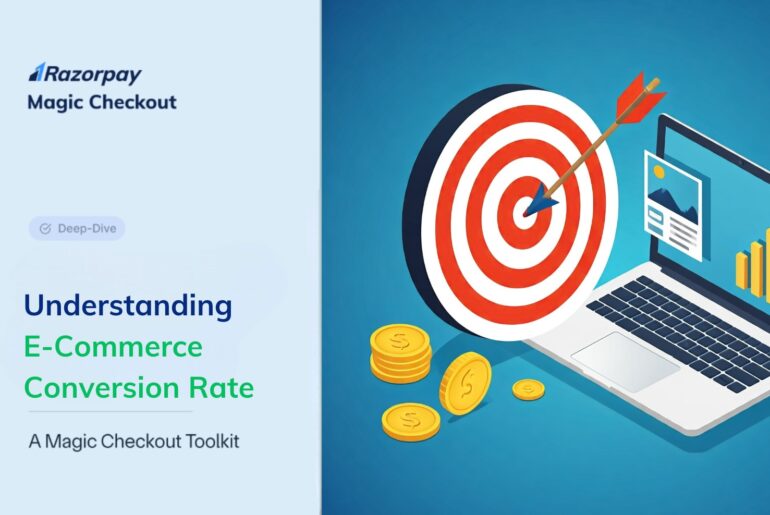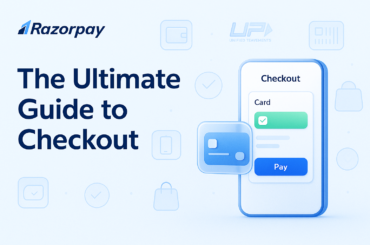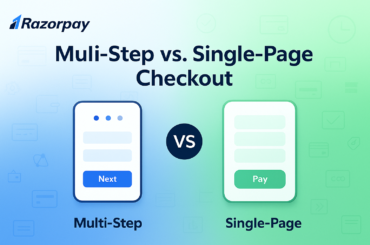Updated on18th October, 2024
Is your e-commerce site getting plenty of traffic but few sales? The reality is, turning visitors into buyers is the key to online success—and your e-commerce conversion rate is the ultimate metric to measure it. Many businesses struggle to improve their conversion rates, often leaving money on the table. But it doesn’t have to be that way. With the right strategies, you can significantly boost your conversion rate and watch your revenue soar. Let’s dive into practical, actionable tactics that will help you turn more clicks into customers.
Table of Contents
TL;DR
Is your e-commerce site struggling with low sales despite high traffic? Your conversion rate—the percentage of visitors who make a purchase—is key. The industry average is around 2.5%, but many businesses fall short, missing out on revenue. Fortunately, you can optimize your site for better conversions with strategies like simplifying the checkout process, A/B testing, and leveraging social proof. And for a real game-changer, consider implementing Magic Checkout to reduce cart abandonment and improve conversion rates effortlessly.
What is E-Commerce Conversion Rate?
An e-commerce conversion rate refers to the percentage of website visitors who complete a desired action, typically making a purchase. This metric is calculated using the formula:
E-commerce Conversion Rate = (Total Orders / Total Website Visits) x 100
For instance, if your site gets 1,000 visitors in a month and 25 of them make a purchase, your e-commerce conversion rate would be (25 / 1,000) x 100 = 2.5%.
Tracking and improving your e-commerce conversion rate ensures that you’re turning potential customers into buyers and maximizing your store’s profitability.
 How to Calculate E-Commerce Conversion Rate?
How to Calculate E-Commerce Conversion Rate?
Conversion rate formula = Total purchases in a specific period of time / Total number of website visits in the same period of time.
Let’s break it down:
- Total purchases in a specific period of time: This refers to the cumulative count of transactions or orders processed on the E-commerce platform during a specified period, whether it’s a day, week, month, or any chosen duration.
- Total number of website visits in the same period of time: This signifies the total number of individuals who have accessed the E-commerce website within the identical designated time frame.
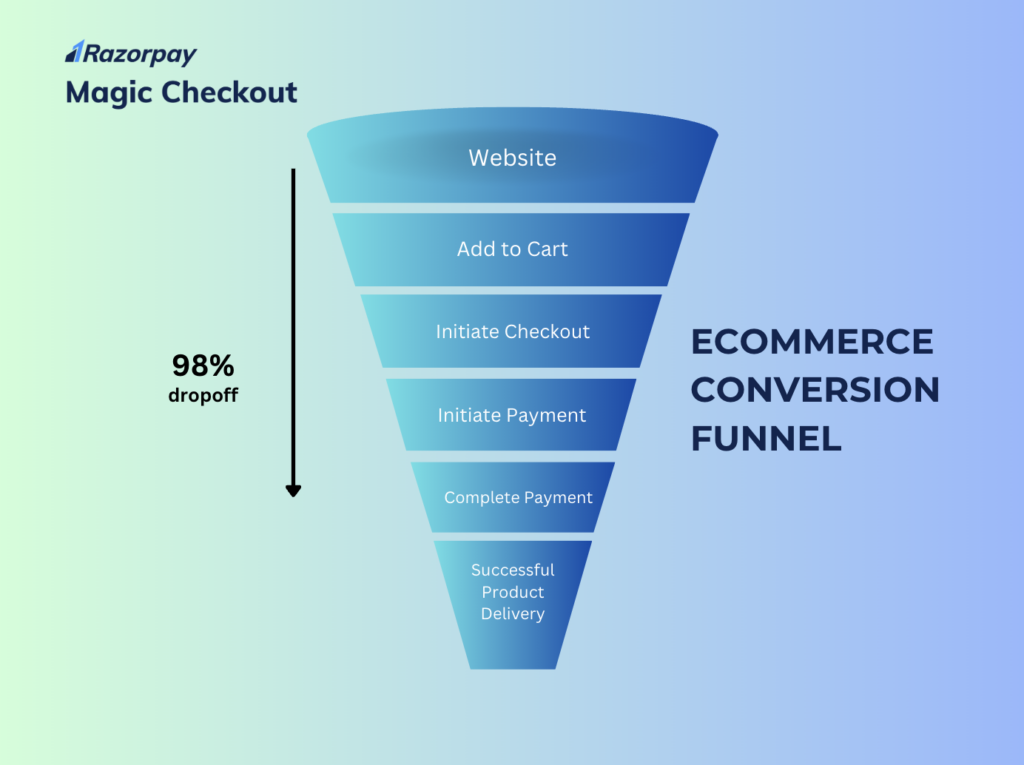
Understanding the Essence of a Healthy E-Commerce Conversion Rate?
The average e-commerce conversion rate across industries is about 2.5% to 3%, but every business is different. For instance, stores on Shopify report an average conversion rate of around 1.4%, meaning there’s plenty of room for improvement. If your store’s rate is lower than 0.5%, it’s time to focus on optimization strategies. Businesses with a conversion rate above 3.3% are in the top 20% of e-commerce stores.
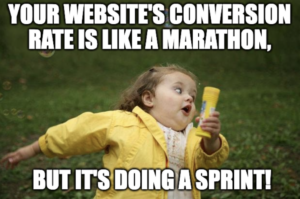
Key Takeaways
- E-Commerce Conversion Rate Basics: Think of it as your website’s success scorecard.
- Benchmark for Success: A “good” CR typically falls between 2.5% and 3%.
- Diverse Industries: E-commerce conversion rates vary widely across different business sectors.
- Stay Industry-Smart: It’s essential to gauge your performance within your specific industry.
- Content Uniqueness: This summary offers a fresh angle on the subject for originality.
Unlocking the Connection Between E-Commerce Conversion Rate and Return on Investment (ROI)
- Driving Revenue: A high CR signifies that a larger portion of your website visitors is actively partaking in preferred actions, such as completing purchases or subscribing to services. This directly leads to boosted revenue, an essential facet of ROI calculation. When your income surges from the same stream of traffic, your ROI naturally flourishes.
- Efficiency in Costs: A high E-commerce CR indicates that your marketing efforts are adept at transforming leads into customers. This efficiency translates to reduced customer acquisition costs. As you spend less on acquiring each customer, your ROI scales higher, reflecting increased value from your marketing budget.
- Boosting Profitability: The E-commerce conversion rate is the engine behind enhanced profitability. Elevated conversion rates often herald greater profitability because they maximize the returns on your investments in product development, marketing campaigns, and user experience. The more adeptly you transform visitors into paying customers, the more profitable your business becomes.
- Measuring Marketing Prowess: Think of E-commerce conversion rate as the tuning fork for your marketing campaigns’ effectiveness. When your conversion rate soars, it’s a clear signal that your marketing endeavors are harmonizing with your intended audience. This translates to a higher return on your marketing investment, a positive influencer on your overall ROI.
- Solid Ground for Expansion: A robust conversion rate lays the groundwork for business expansion. With a website that efficiently converts visitors into customers, you’re poised for confident investments in growth strategies. You know that your ROI is likely to continue its upward trajectory as you expand your customer base.
Conversion Rate Statistics
Website Conversion Rate
The average E-commerce conversion rate is around 2.35%. Therefore, consider setting a conversion rate target of 2-3%, aligning it with the average performance for E-commerce businesses. It’s important to note that individual conversion rates may vary based on factors such as industry, product type, target audience, and marketing strategies. Some websites may achieve higher conversion rates, while others might fall below the average.
Mobile Conversion Rate
The average mobile conversion rate stands at 1.53%. The primary contributing factor to this preference is the limitation posed by smaller screen sizes on mobile devices. The challenge of accurately typing on such screens discourages users from filling out account creation forms or entering payment details, potentially deterring them from purchasing on mobile platforms.
Facebook Ad Conversion Rate
The average Facebook ad CR can differ significantly across various industries. While it is a helpful reference point, there may be better benchmarks for gauging your ad performance. Take, for instance, retail Facebook ads, which have an average CR of only 3.26%; fitness ads enjoy a much higher CR of 14.29%. Understanding these industry-specific variations can help you set more realistic goals and tailor your strategies for optimal results.
E-Commerce Conversion Rate by Vertical
Here is a chart showing the conversion rates across different industries (verticals). According to IRP Commerce, the pet care industry has performed exceptionally well compared to the kitchen and home appliances, health and wellbeing, electrical and commercial equipment, and home accessories and giftware industries regarding conversion rates. The data indicates that the pet care industry has achieved a higher CR, meaning they have been more successful in turning website visitors into customers when compared to the other industries.
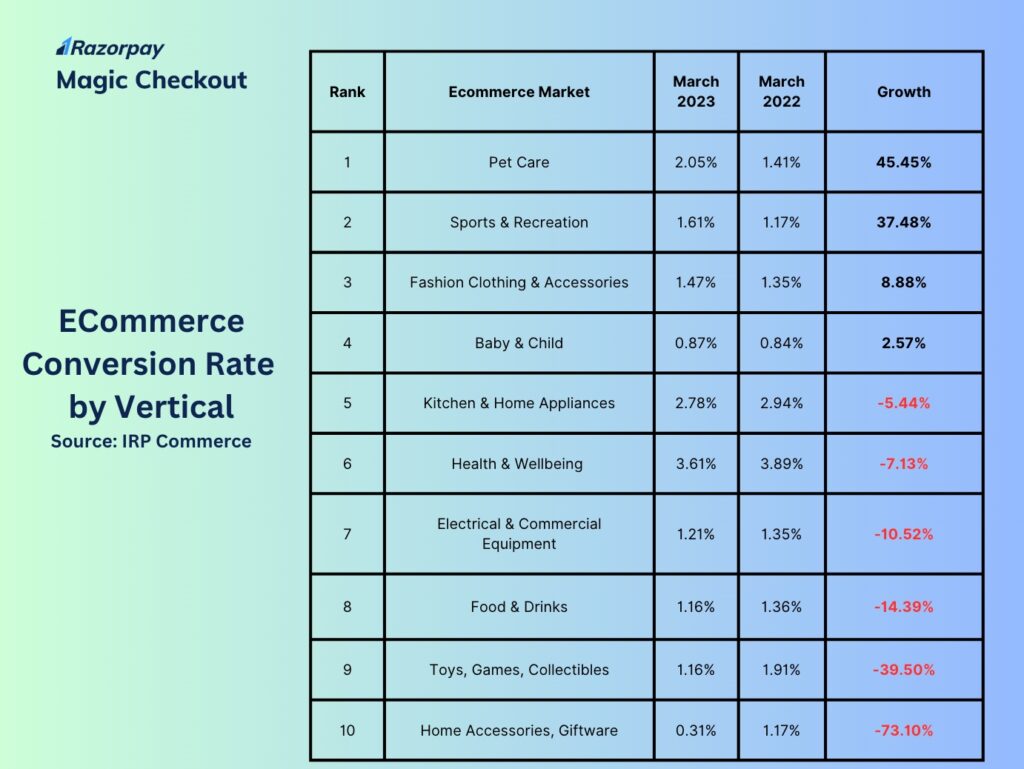 E-Commerce Conversion Rate by Channel/Source
E-Commerce Conversion Rate by Channel/Source
According to the latest Monetate report, the average CR typically hovers from 2% to 3%, although exceptions exist, notably in social media.
In E-commerce, businesses employ various strategies to showcase their products and services. These efforts encompass diverse tactics such as curating product roundups, contributing guest posts on authoritative websites, executing engaging social media campaigns, employing effective SEO techniques, and running targeted paid advertising campaigns.
Understanding the nuances of conversion rates across different traffic sources empowers businesses to fine-tune their marketing strategies. This not only aids in optimizing marketing efforts but also provides valuable insights into the origins of their most valuable customers, aiding in more strategic decision-making.
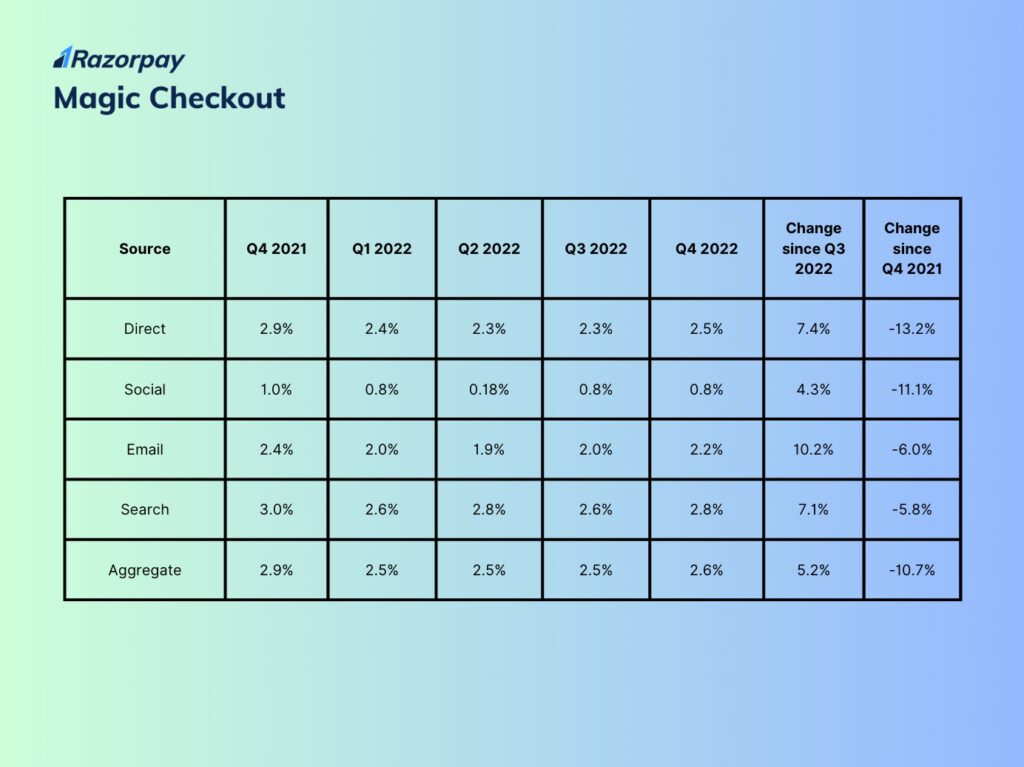 The Importance of Conversion Rate in E-Commerce
The Importance of Conversion Rate in E-Commerce
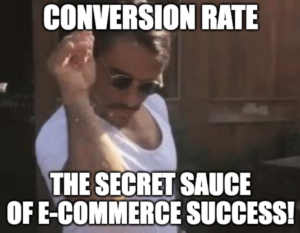
-
Generate Revenue
The significance of E-commerce conversion rate lies in its direct relationship to revenue generation. A higher CR means a more significant portion of visitors is converting into paying customers or engaged leads. This, in turn, leads to increased sales and revenue for the business. Businesses can improve their topline by optimizing CRs without necessarily increasing website traffic.
-
Lower Customer Acquisition Costs
When marketing efforts and strategies are fine-tuned based on data-driven insights from CR analysis, businesses can attract more qualified leads and improve the efficiency of their sales funnel. This leads to a more cost-effective customer acquisition process, ultimately maximizing returns on marketing investments and driving higher profitability.
-
Gain the Competitive Edge
A robust CR can be crucial in attaining a competitive advantage for businesses. When a website’s CR increases, more visitors take the desired actions, such as making purchases or subscribing to services. This signifies that the business better understands its target audience and is effectively meeting their needs. It also allows the business to re-invest more back in business growth.
-
Strategic Budget Allocation
By identifying which channels and campaigns are driving the most conversions, businesses can reallocate resources to the most effective marketing channels, optimizing their budget allocation. Employing a data-centric strategy enables organizations to prioritize actions that deliver optimal outcomes, reducing unnecessary expenses while amplifying the effectiveness of their marketing initiatives.
-
Data-Driven Insights
CR optimization goes beyond simply boosting the percentage of conversions. It opens doors to enhanced data analysis. Enterprises acquire valuable understanding regarding customer behavior, inclinations, and patterns of engagement through vigilant monitoring of conversion rates. This data can be leveraged to refine audience segmentation, create personalized marketing campaigns, and tailor products or services to meet customer needs better.
-
Increase Customer Lifetime Value (CLV)
A higher CR leads to increased customer lifetime value (CLV), a vital metric in measuring a customer’s long-term value to a business. When a website converts visitors into paying customers, the likelihood of repeat purchases and ongoing engagement increases significantly. By optimizing conversion rates, businesses can cultivate stronger customer relationships and foster brand loyalty.
How to Improve Your E-Commerce Conversion Rate
Improving your e-commerce conversion rate might feel challenging, but a few proven tactics can help:
- Develop a Strong Value Proposition: What sets your business apart? Your visitors need to know why they should buy from you instead of a competitor. Ensure your unique selling point is clear across your website.
- Simplify the Checkout Process: Reduce the steps required for a customer to complete a purchase. Make sure your site is mobile-friendly and offers quick payment options like one-click checkout.
- Leverage Social Proof: Show customer reviews, ratings, and testimonials to build trust and reduce buyer hesitation. Potential buyers are more likely to convert when they see positive feedback from others.
Actionable E-Commerce Conversion Rate Optimization Tips:
- Create Clear CTAs: Make sure your call-to-action buttons are visible and persuasive.
- A/B Test Regularly: Test different page layouts, copy, and even images to find what drives conversions best.
- Reduce Cart Abandonment: Implement exit-intent pop-ups or automated email reminders for users who leave items in their cart.
Wrapping Up
Focusing on optimizing your E-commerce conversion rate is essential for achieving business success. Prioritizing customer satisfaction and convenience can foster lasting loyalty, ultimately contributing to your company’s growth. A valuable strategy to boost your E-commerce conversion rate is by considering user-friendly one-click checkout solutions like Razorpay Magic Checkout.
Razorpay Magic Checkout has proven to be beneficial for various E-commerce businesses, including DeoDap and VS Mani & Co., among others. These companies have experienced streamlined customer checkout experiences, with the automated contact and shipping information filling process leading to 5x faster order completion. The enhanced checkout experience has positively impacted their order conversion rates and significantly reduced cart abandonment rates.

